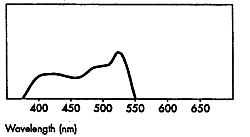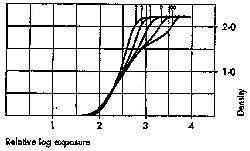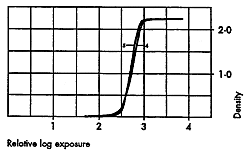
MULTIGRADE FB WARMTONE
PREMIUM QUALITY, WARM TONE, VARIABLE CONTRAST,
BLACK AND WHITE PAPER ON A FIBRE BASE
ILFORD MULTIGRADE FB WARMTONE is a premium quality, variable contrast
black and white paper which has a warm black image tone on a warm white
base. It is especially suitable for toning. MULTIGRADE FB WARMTONE has
a 255g/m2 fibre base.
MULTIGRADE FB WARMTONE is part of the ILFORD MULTIGRADE system and
is fully compatible with all existin MULTIGRADE filters and equipment.
!t is equalgy suitable for printing from conventional bla k and white and
XP2 negatives.
MULTIGRADE FB WARMTONE is available in double weight (1 K) glossy
and 24K semi-matt surfaces.
EXPOSURE
MULTIGRADE FB WARMTONE is designed for use with all enlargers.
Safelight recommendations
MULTIGRADE FB WARMTONE can be used with most common sofelights for
black and white papers. The ILFORD safelights are especially recommended,
however, as they generally allow darkrooms to be brighter, but completely
safe, for MULTIGRADE FB WARMTONE and many black and white papers.
ILFORD safelights ore the ILFORC SL1 darkroom safelight or the ILFORD
902 (light brown) safelight filter fitted in a darkroom lomp (for example,
the ILFORD DLlO or DL2O). A 15W bulb is recommended with these safelights.
For direct lighting, do not expose the paper to the safelight for
more than 4 minutes, and the distance beiween the paper and the safelight
should be a minimum of 1 metre.
Other safelight filters can be used, for example, the Kodak OC and
the Agfa G7, or the Philips PF710 safelamp.
Wedge spectrogram to tungsten light (2850 K)

Contrast range
Seven full grades of contrast, in half grade steps, are available
on MULTIGRADE FB WARMTONE paper when used with the ILFORD MULTIGRADE speed-matched
filters.
Exposing light sources
MULTIGRADE FB WARMTONE is designed for use with most enlargers and
printers, that is, those fitted with either a tungsten or tungsten halogen
light source. It is olso suitable for use with cold cathode (cold light)
light sources designed for voriable contrast papers - further details are
given in the fact sheet'Contrast control'. Other cold cathode (cold light)
and pulsed xenon light sources may give a reduced contrast range.
Contrast control
Contrast is controlled by using MULTIGRADE hand filters, MULTIGRADE
500 equipment, other variable contrast enlarger heads or colour enlarger
heads. Full details on contrast control with MULTIGRADE papers are given
in the fact sheet `Contrast control'.
The twelve MULTIGRADE filters are numbered 00-5 in 1/2 steps, with
the lowest filter number corresponding to the softest contrast. The exposure
time for filters 00-31/2 is the same; that for filters 4,5 is double.
The very sophisticated ILFORD MULTIGRADE 500 exposing system replaces
the standard lamphouse on most professional enlargers.
Characteristic curves
 |
 |
MULTIGRADE FB WARMTONE glossy paper exposed
through filters 00, 0, 1, 2, 3, 4 and 5. Developer: MULTIGRADE diluted
1+9. Development: 2 minutes at 20C.
PROCESSlNG
MULTIGRADE FB WARMTONE is processed in the same way as other fibre
base papers. Further details on processing fibre base papers are given
in the fact sheet 'Processing B&W paper - FB papers'.
Note Photographic chemicals are not hazardous when used correctly.
Always follow the health and safety recommendations on the packoging. Photochemicals
material safety data sheets containing full details for the safe handling,
disposal and transportation of ILFORD chemicals are available from ILFORD.
The image colour of MULTIGRADE FB WARMTONE can be varied with the
choice of developer and the processing technique used.
| Processing summary (intermittent aqitation) |
ILFORD
chemical |
Dilution
|
C
|
Time
(min) |
| Development |
MULTIGRADE developer
or
MULTIGRADE developer
or
BROMOPHEN developer |
1+9
1+14
1+3 |
20
20
20 |
1 1/2-3
2-5
1 1/2-3 |
| Stop bath |
| IN-1 |
1+39 |
18-24 |
5-l0sec |
| Fixation |
| ILFORD PAPER FIXER |
1+3 |
18-24 |
1 |
| Washing |
| Fresh, running water |
- |
Above 5 |
60 |
Development
See the 'Processing summary' for development recommendations.
On correctly exposed prints with MULTIGRADE developer 1+9, the image
will begin to appear after 35 seconds. Development can be extended up to
6 minutes without any noticeable change in contrast or fog.
To give greater control during development, and for economy, the
1 +1 4 dilution of MULTIGRADE developer can be used.
The choice of developer affects the image colour of MULTIGRADE FB
WARMTONE paper. From the ILFORD range of developers, warmest results are
achieved with MULTIGRADE and BROMOPHEN developers.
MULTIGRADE FB WARMTONE paper can also be processed in other high
quality dish developers such as ILFORD PQ UNIVERSAL.
Stop bath
See the 'Processing summary' for stop bath recommendations.
A stop bath stops development immediately, reduces the risk of staining
(which might not show until after toning) and extends the life of the fixer
bath. The use of a stop bath is especially recommended with MULTIGRADE
FB WARMTONE, as this paper carries over more developer to the next bath
than other ILFORD fibre base papers.
A water rinse can be used instead of a stop bath, but it must be
changed frequently to avoid processing marks (which might not show until
after toning).
F ixation
See the 'Processing summary' for fixing recommendations.
The use of a hardening fixer is not recommended as it reduces washing
efficiency, may impair toning performance and gives a cooler image tone.
ILFORD PAPER FIXER is a non-hardening fixer.
There is no benefit in extending fixation beyond the recommended
time; some loss of print quality might be seen when long fixing times are
given due to image etching. Also, long fixing times will affect the image
colour of the paper.
Washing
See the 'Processing summary' for washing recommendations.
Short washing times, for example, when using a washing aid, will
give a cooler image colour than longer washing times. For warmest results,
always wash prints for at least 30 minutes.
Drying
A final rinse in ILFORD ILFOTOL, diluted 1 +200 with water, will
aid even and rapid drying. After washing, squeegee prints on both sides
to remove surplus water. Prints can then be air-dried at room temperature,
glazed or heat-dried. However, the use of belt print dryers and photographic
blotters is not recommended as there is a risk that prints will stick to
them. If a belt print dryer must be used, fix the prints using a hardening
fixer; however, this will have the drawbacks explained under 'Fixation'
.
TONING
Toning prints creates an aesthetic effect and, in some cases, can
help to protect the print from external contaminants - see 'Optimum permanence'.
MULTIGRADE FB WARMTONE is receptive to a wide range of toners and can be
toned to give subtle colour changes or dramatic efFects. Especially recommended
are polysulphide toners, such as Kodak Brown Toner or Agfa Viradon, and
selenium toners. Other toners can be used to create different effects.
Follow the instructions supplied with the toner.
OPTIMUM PERMANENCE
The standard fixing and washing recommendations will give excellent
print permanence for all commercial needs. When optimum permanence is needed,
perhaps for archival storage of prints, the following fixing and washing
sequences at 18-24C (including wash water) are recommended using ILFORD
GALERIE WASHAID. Do not add a hardener to the fixer. Be careful not to
exceed the capacity of the fixer and not to extend the fixing time as both
these make washing more difficult.
0ptimum permanence sequence
Fixation
|
ILFORD PAPER FlXER (1 +3)
intermittent agitation |
1 min
|
| First wash |
Fresh, running water |
5min |
Washing aid
|
GALERIE WASHAID (1+4)
intermittent agitation |
10min
|
| Final wash |
Fresh, running water |
5min* |
* Extend to 30 minutes if the warmest image colour is needed.
0ptimum permanence sequence
with selenium toner
Fixing
|
ILFORD PAPER FIXER (1+3),
intermittent agitation, |
1 min
|
Toning
|
Selenium toner diluted with
working strength GALERIE
WASHAID instead of water,
intermittent agitation |
* min
|
Rinse
|
GALERIE WASHAID (1 +4),
intermittent agitation |
10min
|
| Final wash |
Fresh, running water |
30min |
* Tone the print for the appropriate time to achieve the depth of colour
needed.
For optimum permanence with other toners that give a protective effect,
for example, sulphide (sepia), polysulphide and some metal replacement
toners (gold and platinum), use the optimum permanence sequence above and
then tone the print as desired.
Note Other metal replacement toners such as blue (iron) and red
(copper) toner may not give extra protection as the image might fade. Dye
toners do not give extra protection.
FINISHING
MULTIGRADE FB WARMTONE responds in the same way as other fibre base
papers to the usual techniques of chemical reduction and retouching. It
can be mounted using the standard techniques for fibre base papers. Further
details on finishing fibre base papers are given in the fact sheet 'Processing
B&W paper - FB papers'.
STORAGE
Unprocessed paper
Store unused MULTIGRADE FB WARMTONE paper in a cool, dry place in
its original packaging. Avoid conditions of high temperature and/or high
humidity. MULTIGRADE FB WARMTONE will keep in excellent condition for up
to two years when stored as recommended.
Prints
MULTIGRADE FB WARMTONE prints which have been processed as recommended
in this leaflet will have a more than adequate storage life for most purposes.
Print life will be shortened, however, 'in adverse storoge conditions,
or if the print is exposed to oxidising gases.
It is recommended that prints made for display are toned to protect
them from the oxidising gases that are found in many environments. However,
not all toners protect the image. Toners with a protective effect include
selenium, sulphide and polysulphide toners. Other protection methods can
be used including silver image stabilisers and laminating. Full details
on protecting prints made for display are given in the fact sheet 'Processing
B&W paper - FB papers'.
|





